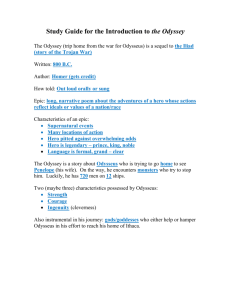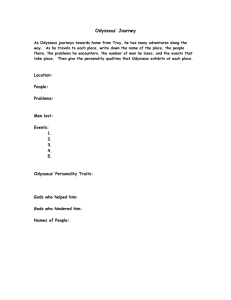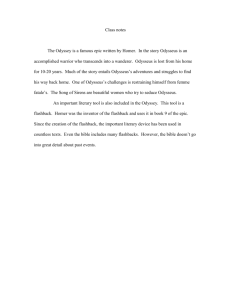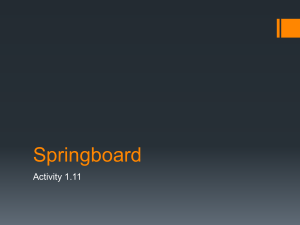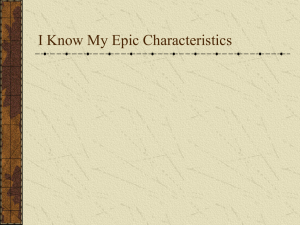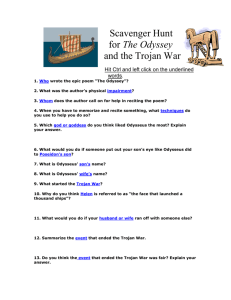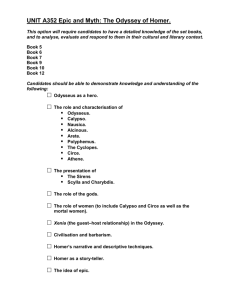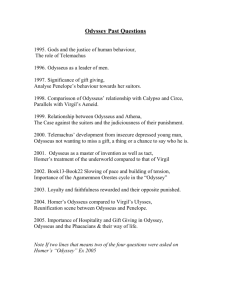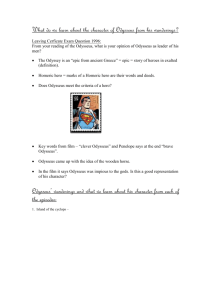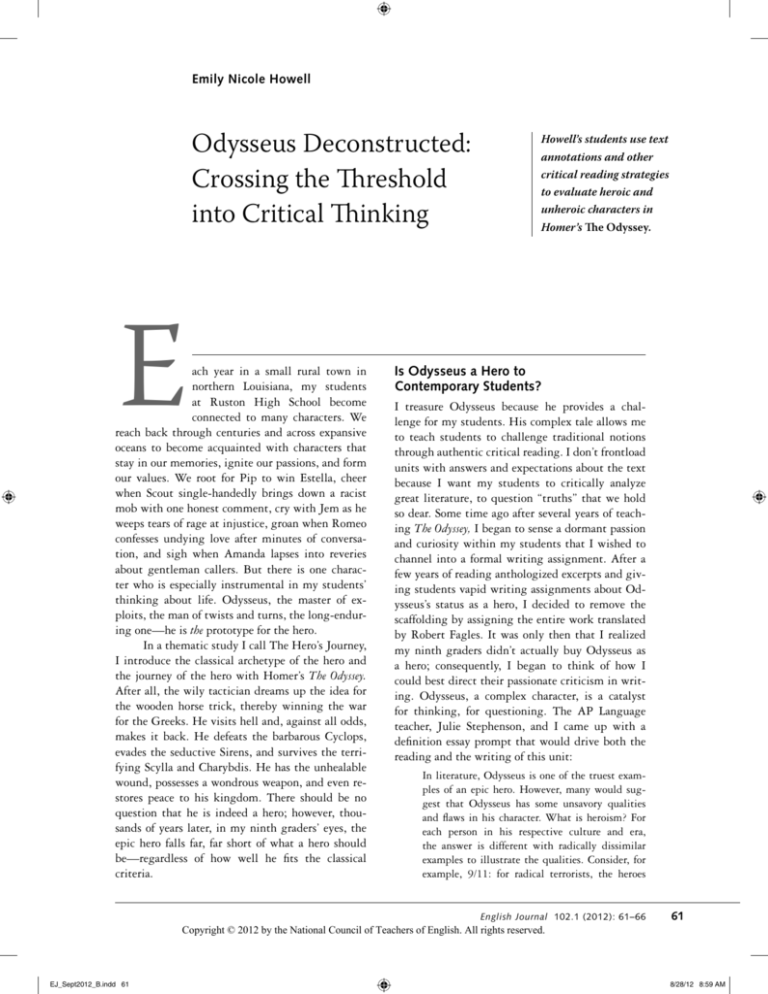
Emily Nicole Howell
Odysseus Deconstructed:
Crossing the Threshold
into Critical Thinking
E
ach year in a small rural town in
northern Louisiana, my students
at Ruston High School become
connected to many characters. We
reach back through centuries and across expansive
oceans to become acquainted with characters that
stay in our memories, ignite our passions, and form
our values. We root for Pip to win Estella, cheer
when Scout single-handedly brings down a racist
mob with one honest comment, cry with Jem as he
weeps tears of rage at injustice, groan when Romeo
confesses undying love after minutes of conversation, and sigh when Amanda lapses into reveries
about gentleman callers. But there is one character who is especially instrumental in my students’
thinking about life. Odysseus, the master of exploits, the man of twists and turns, the long-enduring one—he is the prototype for the hero.
In a thematic study I call The Hero’s Journey,
I introduce the classical archetype of the hero and
the journey of the hero with Homer’s The Odyssey.
After all, the wily tactician dreams up the idea for
the wooden horse trick, thereby winning the war
for the Greeks. He visits hell and, against all odds,
makes it back. He defeats the barbarous Cyclops,
evades the seductive Sirens, and survives the terrifying Scylla and Charybdis. He has the unhealable
wound, possesses a wondrous weapon, and even restores peace to his kingdom. There should be no
question that he is indeed a hero; however, thousands of years later, in my ninth graders’ eyes, the
epic hero falls far, far short of what a hero should
be—regardless of how well he fits the classical
criteria.
Howell’s students use text
annotations and other
critical reading strategies
to evaluate heroic and
unheroic characters in
Homer’s The Odyssey.
Is Odysseus a Hero to
Contemporary Students?
I treasure Odysseus because he provides a challenge for my students. His complex tale allows me
to teach students to challenge traditional notions
through authentic critical reading. I don’t frontload
units with answers and expectations about the text
because I want my students to critically analyze
great literature, to question “truths” that we hold
so dear. Some time ago after several years of teaching The Odyssey, I began to sense a dormant passion
and curiosity within my students that I wished to
channel into a formal writing assignment. After a
few years of reading anthologized excerpts and giving students vapid writing assignments about Odysseus’s status as a hero, I decided to remove the
scaffolding by assigning the entire work translated
by Robert Fagles. It was only then that I realized
my ninth graders didn’t actually buy Odysseus as
a hero; consequently, I began to think of how I
could best direct their passionate criticism in writing. Odysseus, a complex character, is a catalyst
for thinking, for questioning. The AP Language
teacher, Julie Stephenson, and I came up with a
definition essay prompt that would drive both the
reading and the writing of this unit:
In literature, Odysseus is one of the truest examples of an epic hero. However, many would suggest that Odysseus has some unsavory qualities
and flaws in his character. What is heroism? For
each person in his respective culture and era,
the answer is different with radically dissimilar
examples to illustrate the qualities. Consider, for
example, 9/11: for radical terrorists, the heroes
English Journal 102.1 (2012): 61–66
61
Copyright © 2012 by the National Council of Teachers of English. All rights reserved.
EJ_Sept2012_B.indd 61
8/28/12 8:59 AM
Odysseus Deconstructed: Crossing the Threshold into Critical Thinking
of that day were the attackers themselves because
they were willing to die for what they believe; for
most Americans, the heroes of that day were the
firefighters and police officers who survived the
attack but risked their own lives to save the victims; for yet others, the heroes of that day were
the everyday people like those on Flight 93 who
sacrificed their lives to save thousands. Classic literature offers yet more examples—The Iliad, The
Odyssey, Beowulf, etc.—for our consideration. In
a well-supported essay that makes use of textual
evidence, define heroism using examples from The
Odyssey as either positive or negative examples to
support your definition.
Defining heroism is no easy task—especially
with a controversial character like Odysseus. Each
fall, when I initially assign
Fagles’s translation of The
The goal for this unit
Odyssey to my English I class,
is for my students
they balk at the size of the
to struggle through
work, groaning when they
a difficult text—to
realize that it is a really long
essentially begin a
poem. I chose this version of
journey of their own
the text rather than the excerpts in a textbook because
to discover what true
students cannot truly get to
heroism is. Like all great
know Odysseus without readepic adventures, they
ing the whole text. There’s no
do not know where they
scaffolding. There’s no omiswill end up until they’ve
sion of certain scenes. There’s
arrived in their
no canned commentary in italics between famous episodes.
own Ithaca.
It is simply a naked text that
they must adorn with their own thinking. Grant
Wiggins, author of Understanding by Design, asserts
that “If we learned to ‘read’ a philosophy text by
a literal reading, supplemented by what the professor said about it, and if we have not learned to
actively ask and answer questions of meaning as
we read, reading the next book will be no easier”
(41). Likewise, I must teach my students to acquire
a skill set. The goal for this unit is for my students
to struggle through a difficult text—to essentially
begin a journey of their own to discover what true
heroism is. Like all great epic adventures, they do
not know where they will end up until they’ve arrived in their own Ithaca.
As we embark on this odyssey, much like
Odysseus, the students and I cross a threshold of
62
what’s safe, what’s expected. We journey into a land
of darkness and uncertainty from which only the
determined will emerge. To put to death what is
comfortable and launch into a new realm of critical reading is difficult, but the struggle is worth it;
the result is that students learn to read, think, and
write about challenging texts. Most importantly,
they are able to transfer those skills to other works
in the future.
Fostering Critical Reading
To foster critical reading, I have my students annotate the text of the epic (see fig. 1.) Most teachers
have heard that to be a critical reader, you must read
between the lines, but it is paramount to “write between the lines” in order to “make yourself a part of
[the text]” (Adler and Van Doren 49). Each year, as
our reading of the text progresses and as they grow
in confidence, I notice how my students carry the
thick volumes with rough-cut edges around with
pride. They proudly compare their annotations to
their classmates’ and come to class excited because
they found yet another epic simile or epithet. This
book has become a companion, a friend. When the
fire alarm went off in the middle of class this school
year, they grabbed their copies of The Odyssey before
exiting the building, making comments about how
they couldn’t reproduce their annotations. And
they can’t. It is impossible to duplicate the process
of critical reading. Mortimer J. Adler and Charles
Van Doren also assert that “understanding is a twoway operation; the learner has to question himself
and question the teacher . . . [and] be willing to
argue with the teacher” and suggest that annotating a text is “an expression of your differences or
your agreements with the author” (49).
And question the author they certainly do.
As they read, my students grow to see the ancient
hero as the antithesis of heroic. After Odysseus
has returned and the kingdom lives happily ever
after (sans the evil suitors), my students have reduced the epic hero to a sniveling, conniving, selfish miscreant. They see Odysseus, the self-serving
liar, the brutal murderer, the indulgent adulterer.
He is everything that they detest. And they are the
harshest critics. Ninth grader Mike Skipper says
it best: “Many epithets praise Odysseus, . . . but
the loyal husband is not an epithet of his.” Another
September 2012
EJ_Sept2012_B.indd 62
8/28/12 8:59 AM
Emily Nicole Howell
Figure 1. A Student Annotation of the Opening Page of Book Eleven—“The Kingdom of the Dead”
by Mike Skipper, ninth grader at Ruston High School
student, Vincent Grisby, actually an advanced seventh grader taking Pre-AP English I, makes that
critical leap that Adler and Van Doren reference
by questioning our definition of heroism: “[Odysseus] practically beckoned punishment from the
gods. He exhibited an atrocious lack of respect for
the gods, lack of respect for his people, and lack
of consideration for the noble and proud family he
represented. Moments like [these] make you question the definition of hero, seeing that Odysseus is
called one of the greatest heroes of all time.”
Odysseus provides excellent fodder for the
question “What is heroism?” When we first meet
Odysseus in book four, he is staring out at the sea,
sobbing uncontrollably, pining to go home. Initially,
my students feel sympathy for the seasoned veteran
and wonder what unfathomable trials possibly could
have brought the warrior to so lowly a state. But as
we embark on his tale, my students’ pity quickly
wanes, and they promptly become acerbic. They
were already annoyed at the fact that Odysseus had
spent seven years with Calypso “withdrawing into
the cavern’s deep recesses, long in each other’s arms
. . . [losing themselves] in love” (V.250–251). But
when Odysseus washes up in Phaeacia, is found by
the innocent princess Nausicaa (with whom he flirts
shamelessly), and cries uncontrollably at the feast
in an effort to gain a platform to tell his story, it
is too much for my ninth graders. I’ve seen books
slammed down, highlighters thrown. He loses most
credibility at that insincere and contrived moment.
In fact, Margeaux Smith, one of my students, began
her definition essay with these bitter words: “His
voice launching into song, Demodocus, the blind
inspired bard, began to sing of the heroic deeds of
great Odysseus. But where was this brave, courageous man now? Sitting beside [King] Alcinous,
sobbing as if he were a woman with a lost husband
English Journal
EJ_Sept2012_B.indd 63
63
8/28/12 8:59 AM
Odysseus Deconstructed: Crossing the Threshold into Critical Thinking
in battle, was Odysseus, the ‘hero.’” And it only gets
worse as he continues his story.
Obviously, the students quickly discern Odysseus’s hamartia, that is, his tragic flaw, overwhelmingly to be hubris or excessive pride. This
deadly sin is modeled to Odysseus’s men by their
mighty leader, and they all pay the ultimate
price—each one with his life. Stop one on the trip
home from Troy is a swift and brutal plunder of the
village Ismarus by Odysseus’s newly confident and
entitled warriors. Odysseus boasts, “There I sacked
the city, / killed the men, but as for the wives and
plunder, / that rich haul we dragged away from the
place— / we shared it round” (IV.5–8). Odysseus
lets his men run amuck, enjoying their spoils, but
when Odysseus decides it is time to cut and run,
he cannot control his men who have learned the sin
of pride from their leader. The victims of the ambush, the Cicones, get aid from some mighty warrior neighbors, and Odysseus’s men suffer greatly as
a result. My students always have major questions
about these actions. I don’t excuse his behavior; I
let them form their own conclusions and write their
thoughts and criticism in the margins of the text.
Likewise, when Odysseus insists on investigating the cave of the Cyclops Polyphemus, his
insatiable curiosity and lust for fame cost him yet
more men. Odysseus is forever getting his men out
of perilous scrapes, yes, but he is the one who gets
them into trouble in the first place. Scott Huler,
in his book No Man’s Lands:
One Man’s Odyssey through The
Odysseus provides us
Odyssey, describes the dywith a foil—and what my
namic best: “He’s like the guy
students often find is that
in the fraternity who always
the “minor” characters of
gets everyone else in the car in
the epic stack up much
trouble” (120). This episode
better by comparison. My
is found in book nine; there
are 15 more books to go, and
students often choose to
my students are not impressed
focus on the overlooked,
with Odysseus. Again, I enunsung heroes of the
courage my students to keep
epic in order to define
track of their observations by
heroism.
annotating the text. I constantly ask them, “Who’s heroic? Who isn’t?” They must become passionate
about a topic before we expect them to be able to
write well. Isn’t it true that “when student writing
is flat and unfocused, the reason often lies in a fail-
64
ure to provide students with a conversation to argue
in”? (Graff 157; italics in original). After several
weeks of close reading, annotation, and class discussion—and lively arguments—they have a plethora
of ideas from which to choose for their writing.
Lively Arguments about Heroism
After reading the episode with the Cyclops, one of
my students, 14-year-old Hannah Rhodes, came
storming into class with the following commentary
written on an extra-long sticky note since the small
margins of the book just wouldn’t suffice:
What a glory hound! You call that a heroic
leader?! Seriously?! First he brings the wrath of
Zeus on his men by sacking that village, then he
leads several of his men to their death because he
wanted to go up against a Cyclops who was minding his own business! He steals food, invades Polyphemus’ home, steals his sheep, and blinds him!
Then when his crew begs him to stop insulting
Polyphemus, he ignores them and gives in to his
‘fighting spirit’! Egotistical, Proud, Arrogant,
Jerk!!!
I love a good teenage rant, but it is important
to channel student commentary into a productive
direction. If Odysseus isn’t a hero, then who is? If
he doesn’t have admirable traits, then who does?
The beautiful thing about Odysseus is he provides
us with a foil—and what my students often find
is that the “minor” characters of the epic stack up
much better by comparison. My students often
choose to focus on the overlooked, unsung heroes of
the epic in order to define heroism. After weeks of
jotting notes in the margins about all the characters
in the epic, many students choose to define heroism using Penelope, Telemachus, and members of
the servant class as examples in lieu of Odysseus.
In fact, this past year, out of 64 students, only 2
described Odysseus positively. My students’ definitions shed much light on what qualities we value in
a hero today, and their fresh perspective is inspiring.
According to the ninth graders, Penelope,
that constant, faithful companion of Odysseus,
teaches us that true heroism is being faithful and
keeping promises no matter what the consequences.
Although an ancient audience may not have esteemed women as we do today, my students view
her as the truest example of fidelity. Penelope, just
September 2012
EJ_Sept2012_B.indd 64
8/28/12 8:59 AM
Emily Nicole Howell
Mosaic of Odysseus going to meet the Sirens.
as intelligent as her male counterpart, possesses the
quality that her husband lacks—loyalty, and, in the
words of ninth grader Hannah Siegmund, she “uses
her intelligence and determination to defeat evil
and remain faithful until Odysseus’ homecoming.”
My students admire and delight in her prudence
in concocting the shroud trick and later the arrow
and rings trick to foil the suitors, fending them off
until her husband returns. Twelve-year-old Vincent Grisby writes that “Penelope is an astonishing
example of startling resilience in the face of unrelenting challenge, well representing the ideals of
Prometheus (literally, forethought, in Greek).” For
these students, Penelope represents the woman who
will stop at nothing to preserve her family.
The servant class—those salt-of-the-earth,
noble, poor individuals—teach us that heroism is
having integrity, doing the right thing even when
no one is looking. Ninth grader Barrett Moore
came to the conclusion that “the true heroes are
the ones who suffer the most, all . . . while staying loyal and true to the wily tactician, even when
faced with temptation and . . . mockery.” He asserts that it is through a close examination of the
differences between minor characters—Eumaeus,
the kind, loyal swineherd, and Melanthius, the conceited, disloyal goatherd—which Homer’s readers
may learn this lesson. Eumaeus, day after day, tends
to his daily tasks while praying for Odysseus’s return. In sharp contrast, Melanthius takes advantage
of the absent master to ally himself with the wicked
suitors in hopes that he will one day rise in station.
He heaps insult and abuse upon Penelope, Telema-
chus, and the loyal servants and grossly abuses xenia
(the law of hospitality). When Odysseus appears
to be a homeless wanderer, Melanthius attempts
to knock the seemingly withered beggar from the
path and viciously insults him. Eumaeus, however,
treats him with the utmost respect; in fact, in the
words of 15-year-old Taryn Stark, “whether high or
low status, beggar or king, stranger or friend, [Eumaeus] treats everyone with the same respect and
kindness.”
Yet another student muses that “Eumaeus’
loyalty to Odysseus is well-known. He treats his
fellow servants with respect and shows a steadfast
admiration for the royals that he serves, particularly
Prince Telemachus. He accomplishes his job with
a tenacity and vigor that is applied to everything
he does. His actions, not his words or connections,
define how humble and genuine his character is”
(Rhodes).
When I first started teaching this work without using the full text or requiring my students
to annotate, they missed the minor characters
completely. I assumed my students would always
celebrate Odysseus as a great hero of Greek mythology. But my students, bold and curious, question. They ponder. They critique. I never dreamed
that we could learn so much from obscure, minor
characters.
What Is Heroism Today?
It is amazing to me that my students can sit back
in their plastic desks under fluorescent lights while
their iPhones buzz steadily away in their pockets
and be affected by ancient words penned by a bard
so many years ago.
Ninth grader Liam Norton writes that Odysseus’s “presence will be felt for . . . years throughout
various mediums. Any way that one reads of Odysseus, . . . through a book or a Kindle or any other
device, [the reader] can still feel the steel that was
this fiery man.” But what can we learn today from
Odysseus?
Our study of the controversial character of
Odysseus raises an essential question: Has the definition of heroism changed so much over a couple
thousand years? True, we may no longer live by
a warrior code. We don’t worship the gods of the
pantheon. But, has humanity changed so drasti-
English Journal
EJ_Sept2012_B.indd 65
65
8/28/12 8:59 AM
Odysseus Deconstructed: Crossing the Threshold into Critical Thinking
iStockphoto/Thinkstock
cally? I don’t think it has. I believe the answer lies
in Vincent’s paper: “Why did Homer have his protagonist . . . so rudely demean the gods? What was
he trying to tell us?”
There is a subtext in The Odyssey to be discovered by the keen reader. If we dart through the
text in a vain attempt to “cover it,” read adapted
versions, or provide students with summaries and
our own opinions, they miss it. And sometimes we
as adults miss it, too. We must look through the
fresher eyes of young adults to find true meaning
in a text. There are latent warnings throughout the
epic: don’t be prideful; don’t forget where you come
from; appreciate your family. I believe that Homer
wanted us to question Odysseus; he wanted to champion the underdog. So, Homer, I think the muses
heard your referent plea, for you have certainly
“[sung] for our time, too” (I.12).
Works Cited
Adler, Mortimer J., and Charlers Van Doren. How to Read a
Book. New York: Simon, 1972. Print.
Graff, Gerald. Clueless in Academe: How Schooling Obscures the
Life of the Mind. New Haven: Yale UP, 2003. Print.
Homer. The Odyssey. Trans. Robert Fagles. New York: Penguin, 1996. Print.
Huler, Scott. No Man’s Lands: One Man’s Odyssey through The
Odyssey. New York: Three Rivers, 2008. Print.
Wiggins, Grant. Understanding by Design. Upper Saddle
River: Pearson, 2005. Print.
Emily Nicole Howell has had the joy of teaching regular level and Pre-AP English I for six years in the Freshman Academy at
Ruston High School, the only public high school in a small rural town in North Louisiana, where she lives with her husband,
Jason. She was the 2012 Louisiana High School Teacher of the Year and is a national trainer for Laying the Foundation. She
may be reached at ehowell@lincolnschools.org.
R E A D W R I T E T H I N K C O N N E C T I ON
Lisa Storm Fink, RWT
Students can use the online student interactive tool to learn about the elements of the hero’s journey, analyze a
text that follows the hero’s journey pattern, or start creating a hero story of their own. http://www.readwritethink
.org/classroom-resources/student-interactives/hero-journey-30069.html
66
September 2012
EJ_Sept2012_B.indd 66
8/28/12 8:59 AM

